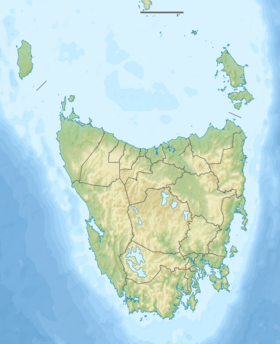The Acropolis (mountain)
For other uses, see Acropolis (disambiguation).
| The Acropolis | |
|---|---|
|
The south face of The Acropolis | |
| Highest point | |
| Elevation | 1,481 m (4,859 ft) [1][2] |
| Prominence | 171 m (561 ft) [2] |
| Isolation | 0.99 km (0.62 mi) [2] |
| Listing | 22nd highest mountain in Tasmania[2] |
| Coordinates | 41°55′48″S 146°03′36″E / 41.93000°S 146.06000°ECoordinates: 41°55′48″S 146°03′36″E / 41.93000°S 146.06000°E [3] |
| Geography | |
 The Acropolis Location in Tasmania | |
| Location | Central Highlands Tasmania, Australia |
| Parent range | Du Cane |
| Topo map | 4235 Du Cane 1:25000 |
| Geology | |
| Age of rock | Jurassic |
| Mountain type | Dolerite |
| Climbing | |
| Easiest route | Walk / hike via the Overland Track |
The Acropolis is a mountain in the Central Highlands region of Tasmania, Australia. Situated in the Cradle Mountain-Lake St Clair National Park, the mountain is part of the Du Cane Range.
With an elevation of 1,481 metres (4,859 ft) above sea level, it is within the top twenty-five highest mountains in Tasmania.[2] It is a major feature of the national park, and is a popular venue with bushwalkers and mountain climbers.
The word acropolis means a high city or citadel.
See also
References
- ↑ "LISTmap (The Acropolis)". Department of Primary Industries and Water. Government of Tasmania. Retrieved 9 February 2010.
- 1 2 3 4 5 "The Acropolis, Australia". Peakbagger.com. Retrieved 7 June 2015.
- ↑ "The Acropolis (TAS)". Gazetteer of Australia online. Geoscience Australia, Australian Government.
External links
- Parks Tasmania
- Kiernan , Kevin (1992). "Mountain geomorphology and the Last Glaciation at Lake St Clair" (PDF). Papers and Proceedings of the Royal Society of Tasmania. Department of Geography and Environmental Studies, University of Tasmania. 126: 47–57. OCLC 271191704. Retrieved 7 June 2015.
This article is issued from Wikipedia - version of the 2/20/2016. The text is available under the Creative Commons Attribution/Share Alike but additional terms may apply for the media files.